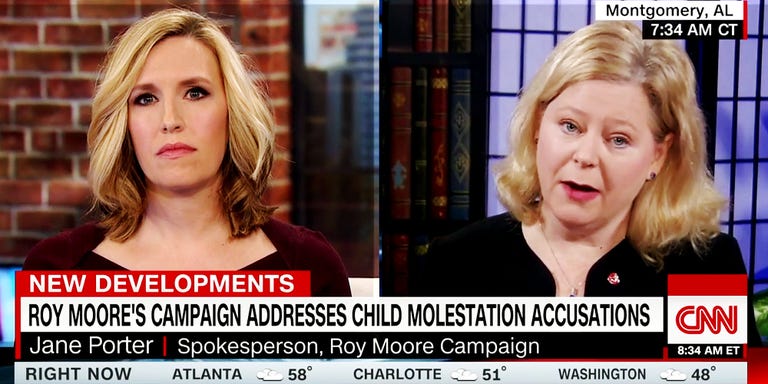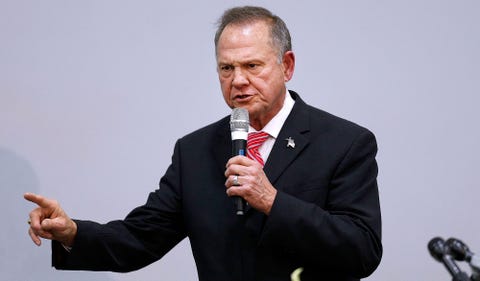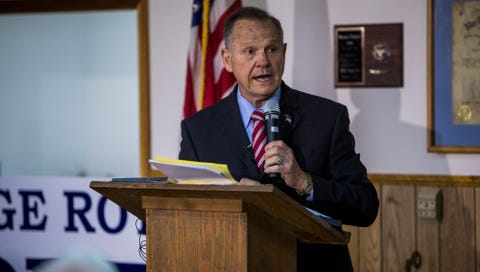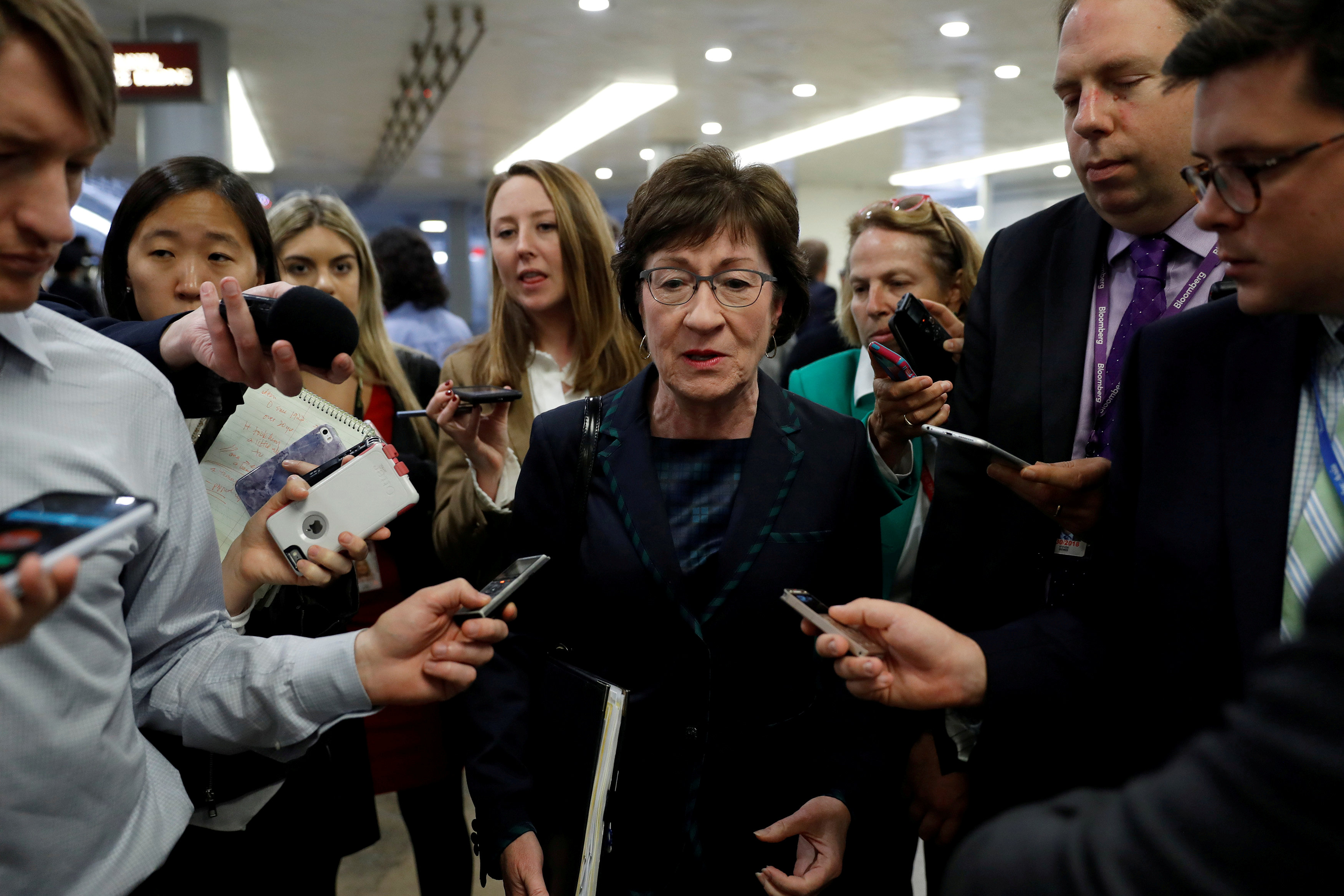Esquire
Roy Moore’s Spokesperson Just Brought His Senate Campaign to a New Low
And, with seven days left, Moore’s team will likely sink further.
 CNN
CNN
By Jack Holmes December 5, 2017
It’s easy to forget that, even before multiple women came forward to allege sexual misconduct against Roy Moore, his United States Senate campaign was already insane. The former Alabama state supreme court judge, thrown out of office twice for disregarding the rulings of higher courts, is uniquely unqualified for public service. If you needed a reminder of that, take a look at the people who have agreed to work on his campaign, such as his spokesperson, Jane Porter. She joined CNN Tuesday morning and kicked things off with a totally normal pregnancy congratulations for anchor Poppy Harlow:
“That’s why I came down as a volunteer to speak for Judge Roy Moore,” Porter said. “He’ll stand for the rights of babies like yours in the womb, while his opponent will support killing them up until the moment of birth.”
Moore’s campaign is hitting the abortion issue hard. Doug Jones, Moore’s Democratic opponent, is firmly pro-choice, though he opposes late term abortions. So, in a true shocker, Porter’s riff is shall-we-say, inaccurate. It brings to mind those Planned Parenthood “sting” videos from the 2016 campaign, which Carly Fiorina harped on incessantly. (Much of the contents turned out to be fabricated.) It also rings a bit hollow when you talk about protecting unborn children, but support a candidate whom one woman says lured her to his house when she was 14 years old and he was 32 and tried to get her to touch his genitals through his tighty-whities.
That woman, Leigh Corfman, is one of at least eight women to accuse Moore of sexual misconduct. We’re getting to the stage where some standup comedian would say, “Anyone here not a Roy Moore accuser?” Actually, that’s close to what Porter said on national television:
Yes, many women have accused Moore of sexual misconduct. But there are 150 million American women who haven’t. Why won’t the Fake News talk about that? This is both shameless and unsurprising. Oh, and that claim about Corfman’s mother undermining her story? That’s based on an attempted Breitbart smear job that admits(remarkably far down the page) that Corman’s mother clearly said the original Washington Post report was “truthful and it was researched very well.”
Sadly, the campaign’s relentless extremism is successful. Moore still incredibly has the support of 6 in 10 white women, evoking the triumph of Donald Trump in that category last year. It’s a stirring reminder that the motivating factor in the Alabama Senate race—as in every contest of this political era—is identity. Specifically, white, Christian, Real American identity versus The Other. White Alabamians will vote for Roy Moore because, like Donald Trump, he’s the White Candidate. Doug Jones, who prosecuted members of the Ku Klux Klan after the Birmingham church bombing, is the candidate of The Other. No matter that Moore is accused of molesting a 14-year-old. He’s tough on crime, while Jones is weak. Maybe that has something to do with who the crimes’ perpetrators are.
 Getty
Getty
That’s been a running theme of Moore’s public career, where he has enforced the most reactionary line on every public policy issue available. Moore is lawless, as his defenestrations from the state supreme court for disregarding higher courts suggest. He is a theocrat, in that one of those removals involved his insistence on keeping a statue of the Ten Commandments on the courthouse grounds, in obvious violation of the First Amendment. He refused to recognize the Supreme Court ruling on same-sex marriage, an assertion that Christian law reigned supreme over United States civil law. Then, in a wicked piece of irony, he yelled and screamed that Sharia law was on the loose in Illinois, with the frightening idea that religious law was taking precedence over civil law. And of course, he once said Muslim Americans elected to Congress should not be seated because they are Muslim.
Oh, and he said women should not be permitted to serve in public office, either.
 Getty
Getty
Moore is probably the worst American politics has to offer, although one hesitates to draw the line based on what’s happened over the last two years. His continued presence in our politics is only possible because the Republican Party has allowed it. That began with the Alabama GOP’s steadfast defense of the candidate, which involved some officials citing the Bible to defend Moore even if he did indeed sexually assault a 14-year-old. It has continued with the national party’s decision to re-enter the race on Moore’s behalf this week, after making a big show of pulling support. That mirrors Senate Majority Leader Mitch McConnell, Moore’s future colleague who went from declaring he believed Moore’s accusers and would demand an ethics investigation into him if he won to simply saying he’ll leave it up to Alabama voters. Oh, and the President of the United States fully endorsed him.
Truly, there is no bottom to the depravity. Moore will likely win the election, and McConnell will seat him in the Senate. His Republican colleagues will probably welcome him as another vote for plutocratic tax “reform,” and for conservative judges nominated for the federal bench. They might think twice about next year’s Bring Your Daughter to Work Day, though.

 A Missouri man was flung from a pickup during a DUI crash, but wasn’t found until hours later when two friends who had survived told his family he was missing. File photo National
A Missouri man was flung from a pickup during a DUI crash, but wasn’t found until hours later when two friends who had survived told his family he was missing. File photo National Katrin Jakobsdottir becomes Iceland’s new PM after a snap election (Picture: AP)
Katrin Jakobsdottir becomes Iceland’s new PM after a snap election (Picture: AP) Her Left-Green party will form a coalition with two parties from across the political spectrum (Picture: AFP)
Her Left-Green party will form a coalition with two parties from across the political spectrum (Picture: AFP) Jakobsdottir campaigned on a platform of restoring trust in government (Picture: Reuters)
Jakobsdottir campaigned on a platform of restoring trust in government (Picture: Reuters) Katrin Jakobsdottir becomes one of the world’s youngest leaders (Picture: EPA) She is now among the world’s youngest leaders.
Katrin Jakobsdottir becomes one of the world’s youngest leaders (Picture: EPA) She is now among the world’s youngest leaders.
 In this Jan. 29, 2015 file photo, Senate Judiciary Committee Chairman Sen. Charles Grassley, R-Iowa is seen on Capitol Hill in Washington, DC. Photo by J. Scott Applewhite/File/AP
In this Jan. 29, 2015 file photo, Senate Judiciary Committee Chairman Sen. Charles Grassley, R-Iowa is seen on Capitol Hill in Washington, DC. Photo by J. Scott Applewhite/File/AP Senate majority leader Mitch McConnell with Senate majority whip John Cornyn, and Senator John Barrasso, talk to reporters, July 25, 2017. (AP Photo / Jacquelyn Martin)
Senate majority leader Mitch McConnell with Senate majority whip John Cornyn, and Senator John Barrasso, talk to reporters, July 25, 2017. (AP Photo / Jacquelyn Martin) Aaron Bernstein | REUTERS | BDN. Sen. Susan Collins, R-Maine. speaks with reporters ahead of the party luncheons on Capitol Hill, Washington, Oct. 3, 2017.
Aaron Bernstein | REUTERS | BDN. Sen. Susan Collins, R-Maine. speaks with reporters ahead of the party luncheons on Capitol Hill, Washington, Oct. 3, 2017.